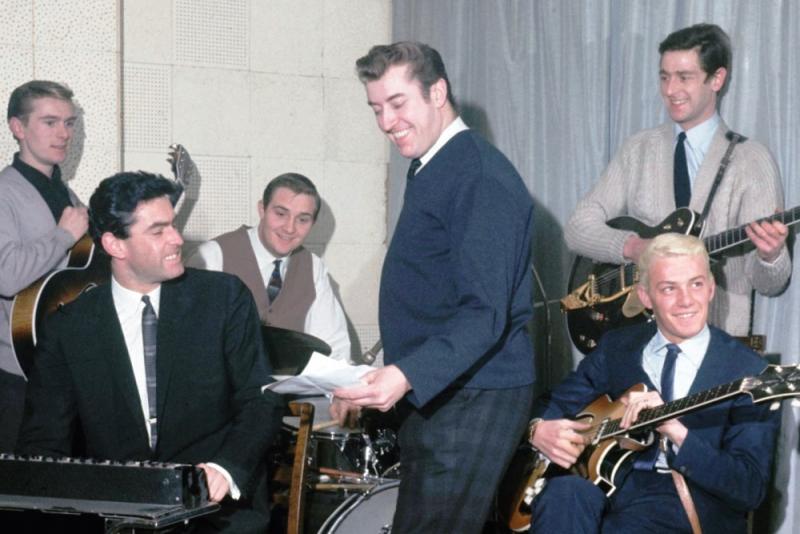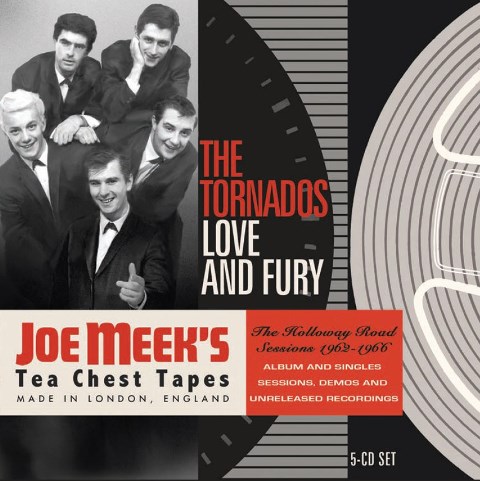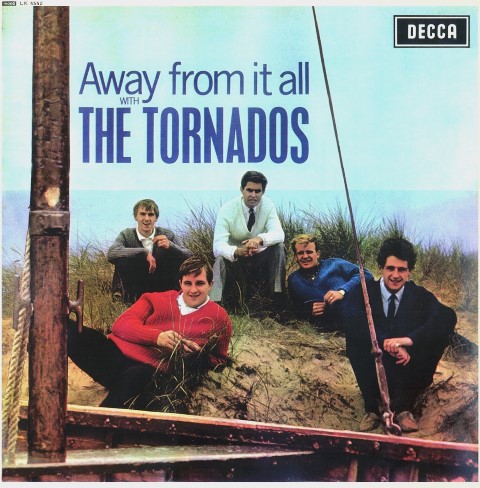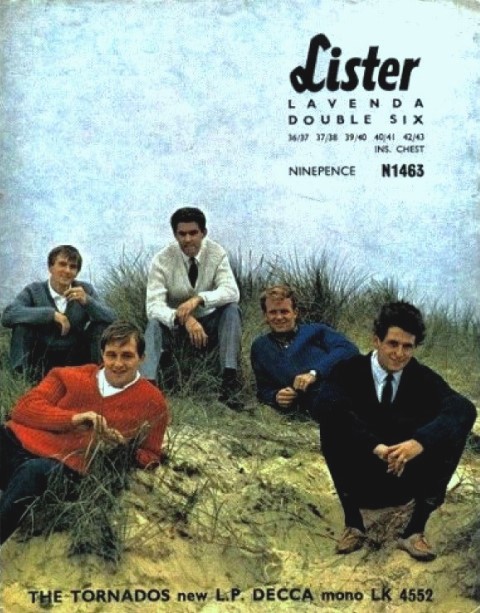Music Reissues Weekly: The Tornados - Love And Fury: The Holloway Road Sessions | reviews, news & interviews
Music Reissues Weekly: The Tornados - Love And Fury: The Holloway Road Sessions
Music Reissues Weekly: The Tornados - Love And Fury: The Holloway Road Sessions
Forensic box-set examination of the Joe Meek-produced ‘Telstar’ hit-makers

In summer 2022, one of the year’s most significant archive releases was issued. The Telstar Story was an eight track 10-inch EP focusing on the aural side of how The Tornados’ 1962 instrumental hit “Telstar” was created by independent producer Joe Meek. There were demos, working material from the recording sessions and much more.
What gave this eye-opening record added oomph was that the source was the actual masters; tape reels previously hidden in what were dubbed “The Tea Chest Tapes” – boxes of reel-to-reel tapes sold by The Official Receiver in 1968 after Meek’s death the previous year. He had killed himself after murdering his landlady. Until 2020, nothing from this archive had been heard (odd tracks had snuck out in lowish-fi). The Telstar Story became the first of an on-going series of releases dedicated to “The Tea Chest Tapes.”
 Love And Fury – The Holloway Road Sessions 1962-1966 goes further than The Telstar Story. It collects 131 tracks by The Tornados across five CDs. This is the last word on The Tornados and their presence in “The Tea Chest Tapes.” There are 119 previously unreleased recordings. As well as what was released, it is stuffed with demos, backing tracks and alternate versions. The Tornados were Billy Fury’s backing band for live appearances between February 1962 and December 1963, and a major find here are four tracks recorded at a Fury/Tornados rehearsal which includes a version of “Halfway to Paradise.”
Love And Fury – The Holloway Road Sessions 1962-1966 goes further than The Telstar Story. It collects 131 tracks by The Tornados across five CDs. This is the last word on The Tornados and their presence in “The Tea Chest Tapes.” There are 119 previously unreleased recordings. As well as what was released, it is stuffed with demos, backing tracks and alternate versions. The Tornados were Billy Fury’s backing band for live appearances between February 1962 and December 1963, and a major find here are four tracks recorded at a Fury/Tornados rehearsal which includes a version of “Halfway to Paradise.”
Equally major are session recordings from what became the final Tornados B-side, “Do You Come Here Often.” The August 1966 single – the top side is “Is That a Ship I Hear” – was a flop. But its flip featured dialogue capturing two gay characters bantering with each other. It’s a fair bet no one at EMI’s Columbia label bothered to listen what they had pressed. The isolated talk heard here – which Meek edited and the dubbed onto the musical track – is unedited.
By this point in 1966, any Tornados release barely registered. Their time had long passed. Intriguingly, a proposed early 1967 post-“Is That a Ship I Hear” Tornados single is heard. Its B-side would have been a version of “No More You and Me,” which The Riot Squad had released. This version is blistering, and features Richie Blackmore contributing some wild guitar.
 Whatever the wonderfulness of this take of “No More You and Me,” Meek would soon be gone, it was forgotten and, anyway, The Tornados hit-making days had ended as 1963 closed. By early 1965, no original members were left in the line-up. Drummer Clem Cattini had been the longest-lasting Tornado, present from their September 1961 beginning when they were formed by Meek as a backing band for his studio sessions. Cattini left around February 1965. The other long-stay player was guitarist Alan Caddy, who shipped out in the first weeks of 1964. Effectively and practically, The Tornados were a vehicle for whatever took Meek’s musical fancy. It didn’t matter who was in the band at any given moment. The identity of who was playing on their 14 singles and one album was irrelevant.
Whatever the wonderfulness of this take of “No More You and Me,” Meek would soon be gone, it was forgotten and, anyway, The Tornados hit-making days had ended as 1963 closed. By early 1965, no original members were left in the line-up. Drummer Clem Cattini had been the longest-lasting Tornado, present from their September 1961 beginning when they were formed by Meek as a backing band for his studio sessions. Cattini left around February 1965. The other long-stay player was guitarist Alan Caddy, who shipped out in the first weeks of 1964. Effectively and practically, The Tornados were a vehicle for whatever took Meek’s musical fancy. It didn’t matter who was in the band at any given moment. The identity of who was playing on their 14 singles and one album was irrelevant.
As a result of this churn, listening to Love And Fury – The Holloway Road Sessions is more about Meek than it is one guitar player or another, this drummer, that drummer. While, for example, Caddy and Cattini were stellar musicians what they played and the end result was to do with Meek. Obviously, a rock ’n’ roll cover like “Rip it up” would be something the musicians liked, but as to who chose to make what turned out to be a horrible version of “Chattanooga Choo Choo?” Probably Meek.
 All this notwithstanding, there is what comes across as an endless stream of treasures here – all in super-fi sound, straight from the master tapes. Take the five tracks on Disc Three dedicated to the evolution of “Life On Venus,” a March 1963 B-side. Hearing the individual elements as they are created and then put together to make the final, released track reveals Meek’s painstaking approach. He may have been maddening in person, but he knew to create a complete picture from a patchwork.
All this notwithstanding, there is what comes across as an endless stream of treasures here – all in super-fi sound, straight from the master tapes. Take the five tracks on Disc Three dedicated to the evolution of “Life On Venus,” a March 1963 B-side. Hearing the individual elements as they are created and then put together to make the final, released track reveals Meek’s painstaking approach. He may have been maddening in person, but he knew to create a complete picture from a patchwork.
Even so, by this point their producer was less fixated on the post-“Telstar” Tornados than earlier. He had plucked their bassist Heinz from the band and from early 1963 dedicated himself to making the dyed-blond bombshell into a solo star. But as this set shows, The Tornados weren’t entirely left behind despite the potential for Johnny Anyone becoming a member of the band.
The peculiar status of The Tornados is exemplified by their inconsistent sole album, August 1963’s Away From It All (pictured above left). On its cover, they sit on a sand dune looking like five suburban men about to do some gentle gardening, pruning perhaps. An utterly un-rock ’n’ roll image with no place in the rapidly changing world of British pop. Bizarrely, this was underpinned by the availability of a tie-in knitting pattern for the jumpers they are wearing (pictured above right). Who would have wanted to make their own Tornados jumper; to look like a Tornado? Hardly on a par with buying Beatle boots.
For Meek, The Tornados were about what went on inside his studio and his head – about fashioning the music. With this in mind, dive into Love And Fury – The Holloway Road Sessions 1962-1966 with the “Life On Venus” section as the opening shot. Then whizz forward to “Do You Come Here Often.” Let these settle in and, afterwards, begin from the beginning and hear these extraordinary, important five CDs as a previously unheard aural diary: an interrelated series of snapshots of how a particular strand of British Sixties pop was created.
- Next week: Scott Fagan's South Atlantic Blues - the return of the 1968 singer-songwriter album
- More reissue reviews on theartsdesk
- Kieron Tyler’s website
Explore topics
Share this article
The future of Arts Journalism
You can stop theartsdesk.com closing!
We urgently need financing to survive. Our fundraising drive has thus far raised £49,000 but we need to reach £100,000 or we will be forced to close. Please contribute here: https://gofund.me/c3f6033d
And if you can forward this information to anyone who might assist, we’d be grateful.

Subscribe to theartsdesk.com
Thank you for continuing to read our work on theartsdesk.com. For unlimited access to every article in its entirety, including our archive of more than 15,000 pieces, we're asking for £5 per month or £40 per year. We feel it's a very good deal, and hope you do too.
To take a subscription now simply click here.
And if you're looking for that extra gift for a friend or family member, why not treat them to a theartsdesk.com gift subscription?
more New music
 Music Reissues Weekly: Evie Sands - I Can’t Let Go
Diligent, treasure-packed tribute to one of Sixties’ America’s great vocal stylists
Music Reissues Weekly: Evie Sands - I Can’t Let Go
Diligent, treasure-packed tribute to one of Sixties’ America’s great vocal stylists
 'Deadbeat': Tame Impala's downbeat rave-inspired latest
Fifth album from Australian project grooves but falls flat
'Deadbeat': Tame Impala's downbeat rave-inspired latest
Fifth album from Australian project grooves but falls flat
 Heartbreak and soaring beauty on Chrissie Hynde & Pals' Duets Special
The great Pretender at her most romantic and on the form of her life
Heartbreak and soaring beauty on Chrissie Hynde & Pals' Duets Special
The great Pretender at her most romantic and on the form of her life
 The Last Dinner Party's 'From the Pyre' is as enjoyable as it is over-the-top
Musically sophisticated five-piece ramp up the excesses but remain contagiously pop
The Last Dinner Party's 'From the Pyre' is as enjoyable as it is over-the-top
Musically sophisticated five-piece ramp up the excesses but remain contagiously pop
 Moroccan Gnawa comes to Manhattan with 'Saha Gnawa'
Trance and tradition meet Afrofuturism in Manhattan
Moroccan Gnawa comes to Manhattan with 'Saha Gnawa'
Trance and tradition meet Afrofuturism in Manhattan
 Soulwax’s 'All Systems Are Lying' lays down some tasty yet gritty electro-pop
Belgian dancefloor veterans return to the fray with a dark, pop-orientated sound
Soulwax’s 'All Systems Are Lying' lays down some tasty yet gritty electro-pop
Belgian dancefloor veterans return to the fray with a dark, pop-orientated sound
 Music Reissues Weekly: Marc and the Mambas - Three Black Nights Of Little Black Bites
When Marc Almond took time out from Soft Cell
Music Reissues Weekly: Marc and the Mambas - Three Black Nights Of Little Black Bites
When Marc Almond took time out from Soft Cell
 Album: Mobb Deep - Infinite
A solid tribute to a legendary history
Album: Mobb Deep - Infinite
A solid tribute to a legendary history
 Album: Boz Scaggs - Detour
Smooth and soulful standards from an old pro
Album: Boz Scaggs - Detour
Smooth and soulful standards from an old pro
 Emily A. Sprague realises a Japanese dream on 'Cloud Time'
A set of live improvisations that drift in and out of real beauty
Emily A. Sprague realises a Japanese dream on 'Cloud Time'
A set of live improvisations that drift in and out of real beauty
 Trio Da Kali, Milton Court review - Mali masters make the ancient new
Three supreme musicians from Bamako in transcendent mood
Trio Da Kali, Milton Court review - Mali masters make the ancient new
Three supreme musicians from Bamako in transcendent mood
 Hollie Cook's 'Shy Girl' isn't heavyweight but has a summery reggae lilt
Tropical-tinted downtempo pop that's likeable if uneventful
Hollie Cook's 'Shy Girl' isn't heavyweight but has a summery reggae lilt
Tropical-tinted downtempo pop that's likeable if uneventful

Add comment